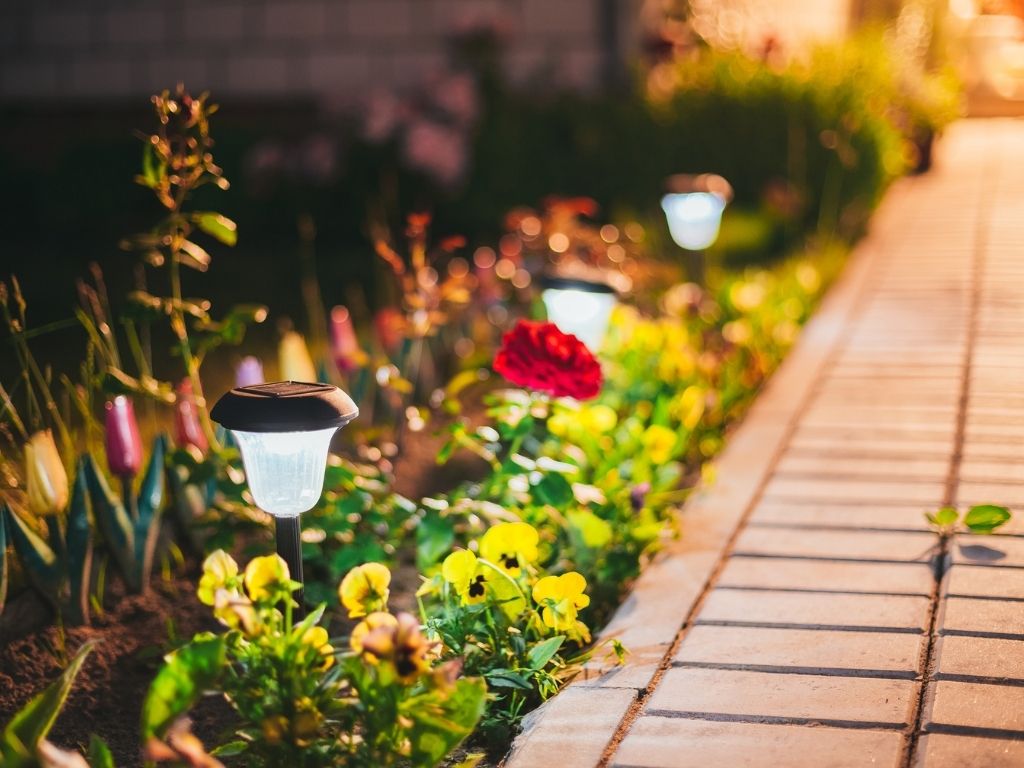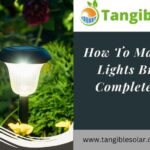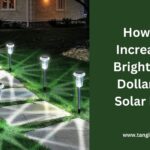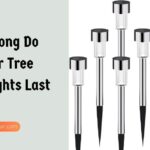How to Make Solar Garden Lights Brighter- 9 Incredible Ideas?
How to make solar garden lights brighter has recently gained popularity due to their positive environmental impact and reduced electrical energy consumption, which results in lower expenses.
Because fossil fuels are both dangerous and nonrenewable, they are becoming less popular. Many little solar panels convert sunlight into energy for solar garden lighting. This energy is what powers the LEDs in the solar garden lights. The lights can become dimmer if they are not properly maintained. “What are some solar light hacks?” and “How to Make Solar Garden Lights Brighter?” are questions that solar-powered dusk-to-dawn light owners frequently ask.
Let’s get started talking about what changes you can make in your daily life to help your solar lights shine brighter.

Best 9 Steps to Make Your Solar Garden Lights Brighter
1. Examine the panels for dirt.
Your solar light may have become soiled. Examine it for any dirt or leaves that may have found their way inside. Additionally, if your light is dirty, it may be dimming the light. If that’s the case, a thorough cleaning may be required. Dirt also hinders sunlight from reaching the panel, resulting in decreased light absorption. Because there is less light, the battery has less energy and will last less during the night.
2. Verify that it is turned on.
This has happened to all of us on several occasions. If your light isn’t working at all, check the button and, if your solar garden light has one, the electrical outlet to see if you’ve turned it on. It’s also possible that you neglected to take off the plastic barrier that’s usually attached to the battery ends. Because plastic is an insulator, it may be obstructing current flow.
3. Examine the batteries.
When the weather is cold, it may be preferable to bring in solar lights. They can wreak havoc on the panels, causing damage and decreasing the life of the panels. It’s more likely to last longer if you take care of your merchandise. The battery might corrode after lengthy usage, which is why you should examine the health of your battery. If it’s broken, you should get rid of it and replace it with one that works properly. If the battery shows signs of rust, or damage, or appears to be larger than it should be, it should be replaced. When removing the battery, corrosion may be discovered on the solar light parts as well, not just the battery. If that’s the case, make sure you sand the rusted sections down to remove the rust.
4. Pay Attention to the Light During the Day.
Try this one if none of the others work. It’s critical to find a location where the solar light may be exposed to direct sunlight throughout the day to maximize battery charging. If your solar light is located in a location where the sun is obscured for an extended period, you may need to change your solar garden lights and relocate them to a location where the sun is more accessible. Modifying solar garden lights may entail simply changing the angle or relocating it slightly; it does not have to be a complete overhaul or solar light replacement.
5. Keep an eye out at night
Examine how long and how brightly your lights are on at night. If you can borrow an identical lamp from someone else or have two, you can simply compare the models to see if the dimming is due to the model or if the dimming is due to wear and tear.
Trying to diagnose the problem this way might help you figure out whether the model is fine as is and you just need a brighter one, or whether the one you bought needs to be fixed.
6. Attempt to repair it
If your Solar Powered light has been on for a long time, it may be helpful to turn it off for a day or two. Solar panels ensure that the battery is charged even when the lights are turned off, so you don’t have to worry about your device taking longer to set once it is switched on. They should be brilliant solar lights after they’ve been turned on. Try opening them if this doesn’t work and they’re still weak. Examine the screws and obtain a compatible screwdriver. Unscrew it and look inside for any residue or dirt. If required, clean.
7. Get in touch with tech support
If you’re positive there’s something phallic about your lights and you’re powerless to stop it, contact assistance. They’ve been trained to understand the product, establish a diagnosis, and guide you through your goal to repair it.
People frequently avoid calling tech support because they don’t want to wait or believe the person on the other end of the line doesn’t know what they’re talking about. You might come across a new employee who isn’t particularly helpful at first, but there’s no reason not to give support a shot.
If the store where you got your product doesn’t answer the phone or can’t help you, it can be a good idea to drive there with the lamp. This provides you the opportunity to outline what you’ve tried, have a debate, and possibly come up with a solution to the problem with your lamp. When it comes to this type of stuff, face-to-face interactions are frequently more fruitful and simply faster. Remember to bring your warranty with you; you may need it to get your solar lights repaired or replaced.
8. Additional Suggestions
Check to see whether other customers have mentioned your model’s lights as dim in reviews. Some of the lights are meant to be a little softer. This will help you decide whether or not to replace your current lights.
Every week, clean the top of the panel. Debris, fungi, or filth, in general, could be the cause of your lights not operating properly.
Regardless, replace your battery. It could be something you don’t notice, but switching to a different one is the last resort when trying to fix your lights.
9. Obtain a replacement
There may not be much more you can do in the end. Whether you’re certain your lights aren’t as bright as they once were and you need or desire brighter ones, consider contacting the manufacturer and asking if a solar light replacement is available. How Do Solar Powered Lights Work
How to Make Solar Garden Lights Brighter FAQ
1. What causes my solar lights to be so dim?
The batteries are typically to blame when solar-powered lights don’t work. Either they are not holding it or they are not receiving a charge. If the lights function with regular batteries, it is obvious that the solar panel or the rechargeable batteries are the cause of the issue.
2. Do overcast days allow solar lights to recharge?
Yes is the quick answer. Solar panels need direct sunlight to charge, although they can also be charged on cloudy, overcast days. For instance, Sol’s cutting-edge lighting systems and products are intended to function for at least four days without direct sunlight.
3. What is the solar light’s maximum lumen output?
The production of light might differ greatly from one light to another. Some lights have a maximum output of 15–20 lumens, which creates a gentle light with a mellow amber hue. Other solar lights can emit a brighter (and harsher) light with a far higher brightness rating
4. How long are solar lights illuminated?
The majority of solar lamps have a runtime of 6 to 10 hours with a full battery. This was specifically created so that, after a day of typical sunlight, lights could run all night.
5. What sort of batteries do you employ for solar lighting outside?
The most popular size of rechargeable battery for solar lights is thought to be AA batteries. One model may have a different battery capacity than another. Here, the term “capacity” refers to the amount of time, measured in milliamp-hours, that a battery can produce power (mAh).
6. Do the batteries in solar lights need to be changed?
You must remove the solar batteries from solar lights before storing them for the winter to prolong their life. You will need to replace the old batteries if you tested the solar lights using the old batteries and they continued to malfunction even after being charged all day.
Conclusion
Don’t panic if your How to Make Solar Garden Lights Brighter lamp doesn’t work; there are still a few things you may do before returning it or replacing it with a new one. The skill could be as simple as cleaning them or as hard as trying to fix them, but you can do either, and it won’t cost you anything. All you need is a determination to get down to business.
Whether you are successful in repairing or replacing your lights, you are being environmentally conscious. You’re using renewable energy sources that don’t pollute the environment. 15 Best Outdoor Solar Step Lights Reviews




